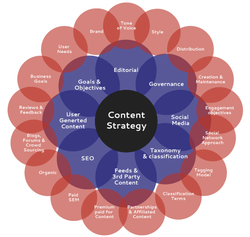
There are many types of content, of course, and each group of assets may have a different strategy entirely. Let’s look at how you can identify that content, organize it and execute a strategy to handle it.
Step One: Identify Our Content
Let’s first start by identifying your content assets. What content do you have? How and why is it currently being used? Start by asking these kinds of questions to assess the content assets so you can later evaluate and organize that information into groups used in taxonomy (categorization of your content) and so forth.
Identifying your content is an important first step because, obviously, you have to know what you are working with before you can actually develop a plan to organize and use that available data to your advantage as an organization. Try to create some type of outline as you work through this.
For instance, you will likely want to look at all of your marketing content, employee policy content, customer and financial data and business operational data all separately. Find where all of this content lives (in the cloud, data center, computer hard drives, network drives, social media, email, wikis, etc.). This will help you move into the next crucial step of the content strategy process, which involves organizing all of your content and grouping it into categorical context.
Step Two: Organize, label, categorize
So now that you have identified all of the content within your organization’s hard (such as those in a file cabinet) and soft files (such as those in the cloud or stored on a computer), you can begin the critical steps of organizing, labeling and categorizing your content. This process involves creating an outline, hierarchy or taxonomical system for your content assets.
You will first want to start with a plan that outlines your organization’s goals for the content, with your overall mission in mind, so you will be able to develop a useful system of organization and taxonomy. Group your content assets within these groups and subgroups to create cohesion and transparency. One of the goals of your content strategy should be to make data easier to access for those with the proper access privileges. Each layer may have different privileges or added layers within. It is kind of like baking a complicated cake, using data for our ingredients.
Step Three: Develop targeted plans for each layer
Because you have these different layers of content, it only makes sense that you must plan a slightly or even widely different approach to each of those layers. For instance, your strategy for delivering employee policy and conduct information surely would not use the same approach as delivering customer marketing material to the public. They must be implemented with the user in mind.
Part of this is about identifying the user or audience in mind, but much of that process should have been already taken care of during the organization phase.
These layers of taxonomy (content that is tagged or categorized for use in a particular context or definition of terms or navigation) can become increasingly complex and overwhelming, even for the most seasoned content managers, so be vigilant and stay focused on the overall strategy.
There are two good ways to do this. One is to make sure that you audit your content for consistency, accuracy, relevance (outdated information should be archived), mechanics, usability and design. The next is to conduct usability testing through each phase of the content management overhaul.
Step Four: Find a content management system that works for you
There are many different content management systems (CMS) that have varying levels of efficiency, complexity and advanced features for editing and managing your content. Each one is different and has a different learning curve.
Your job should be to find the one that works best for the purposes intended. Possible CMS include Drupal, WordPress, Joomla and several others for content like blogs, web portals and basic (or complex) websites. Sharepoint helps to manage document files. There are a number of different options depending on a particular need. You just want to make sure that your chosen system will allow you to categorize content effectively and make search easier.
Step Five: Employ good user design or user experience principles in design and navigation
It can’t be stressed enough. Make finding content easier for members of you organization. Make sure your content strategy involves looking at both form and function of content. A good information designer or graphic designer should not be underestimated. The work they do helps people navigate complicated websites or applications easier.
Designs should be clean and clear of clutter and complicated imagery. Icons and images should be displayed in the proper format so they don’t appear distorted. They should be easy to read, easy to find and easy to digest. Web users typically have little patience when it comes to looking around the page. You literally have seconds to grab their attention. Make it count.
Navigation structure and page elements should also be displayed logically and in a clean and clear manner to avoid confusion and congestion on pages. Also ensure that all navigation leads to relevant content that is useful for the intended audience.
Step Six: Employ analytics to make the most of your content
Lastly, when developing a content strategy and after all the other five steps have been completed (this is an ongoing though), you will be able to analyze your data. Using analytics tools to access insights about information can be critical to making your content strategy work for the organization. Look at how users clicked, where they clicked, what content was most accessed, how it was accessed and why. These insights will allow you to be nimble and make gradual changes over time to continually tweak the content management process.
 RSS Feed
RSS Feed
